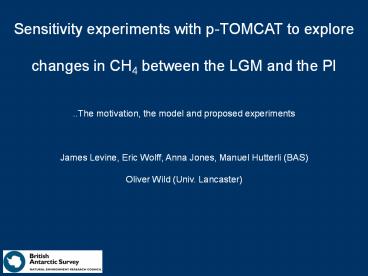Sensitivity experiments with p-TOMCAT to explore - PowerPoint PPT Presentation
1 / 13
Title:
Sensitivity experiments with p-TOMCAT to explore
Description:
Sensitivity experiments with p-TOMCAT to explore. changes in CH4 between the LGM and the PI. ... Photolysis rates are calculated offline with Cambridge 2D model ... – PowerPoint PPT presentation
Number of Views:73
Avg rating:3.0/5.0
Title: Sensitivity experiments with p-TOMCAT to explore
1
Sensitivity experiments with p-TOMCAT to
explore changes in CH4 between the LGM and the
PI ..The motivation, the model and proposed
experiments James Levine, Eric Wolff, Anna
Jones, Manuel Hutterli (BAS) Oliver Wild (Univ.
Lancaster)
2
Changes in CH4 accompanying changes in climate
PI
B/A
D-O8
YD
LGM
3
Changes in CH4 accompanying changes in climate
PI 700 ppbv
B/A
D-O8
YD
LGM
360 ppbv
4
Accounting for observed changes in CH4 Model
studies suggest changes in CH4 sources (e.g.
emissions from wetlands) cannot fully account for
the LGM-PI change in CH4Some studies suggest
changes in CH4 sinks are also important, with
higher OH at the LGM as a result of lower VOC
emissionsLaboratory studies predict lower VOC
emissions at the LGM based on DT but allow for
higher emissions based on DCO2..The balance
b/w changes in sources and sinks remains uncertain
5
Distinguishing between changes in sources
sinks Previous studies re CH4 sinks have largely
taken a top down approach, attributing observed
changes in chemical composition (e.g. HCHO,
H2O2 and ?17O) to changes in oxidising
capacity We will take a bottom up approach,
changing OH (or CH4 emissions), modelling the
impact on atm. chemical composition and
identifying any changes that may be preserved in
the ice
6
The chemistry-transport model, p-TOMCAT
3D global tropospheric CTM
(s-pressure levels to 10 hPa) An
update of TOMCAT CTM Winds
calculated offline (ECMWF
operational analyses) Run at a
variety of resolutions (typically
2.8 x 2.8 x 31L)
7
The chemistry-transport model, p-TOMCAT
Chemistry scheme includes 63 species (38
advected) plus 37 photolytic, 119 bimolecular
and 18 termolecular reactions Photolysis
rates are calculated offline with Cambridge 2D
model that also provides top-boundary
conditions for O3, CH4 and NOy Emissions
include CH4, isoprene, CO, Me2CO, HCHO, NO2
Wet and dry deposition (rainout linked to
convection scheme) No halocarbon
or heterogeneous chemistry
8
Sensitivity experiments with p-TOMCAT Strictly
speaking, our aim is not to quantify the changes
in CH4 sources and sinks between the LGM and the
PI but to identify any chemical signals with
which these changes can be quantified To this
end, we will use p-TOMCAT to explore how a wide
variety of chemical species are affected by a
change in OH, or CH4 emissions, sufficient to
account for the LGM-PI change in CH4
9
Sensitivity experiments with p-TOMCAT
PI 700 ppbv
B/A
D-O8
YD
LGM
360 ppbv
10
Sensitivity experiments with p-TOMCAT
Once the model is set up for the PI, Reduce
CH4 emissions to obtain CH4 typical of the
LGM Increase OH to obtain CH4 typical of
the LGM O(1D) H2O n OH (where
ngt2) ? Explore the impact of changing VOC
emissions
11
Sensitivity experiments with p-TOMCAT
Time permitting, We could explore
sensitivities to changes in the distribution
of CH4 emissions, including the inter-
hemispheric gradient in CH4 We could also
explore sensitivities to changes in other trace
gases (CO, NOx, H2O and O3) and climate
12
Where we are up to We have run the model
(p-TOMCAT) on the Dobson cluster (CAS) and are
currently porting the model to Hades (BAS) Our
next step is to implement PI emissions (i.e. set
the model up for the PI) we hope to have done so
by mid October We aim to present preliminary
results to at least one sensitivity experiment at
the QUEST meeting in December
13
Acknowledgements Glenn Carver (Univ.
Cambridge) Porting p-TOMCAT to HADES
(BAS) Nicola Warwick and Guang Zeng (Univ.
Cambridge) Changing the emissions in
p-TOMCAT Paul Valdes and Sarah Nelson (Univ.
Bristol) PI and LGM emissions (Valdes et
al., 2005)

